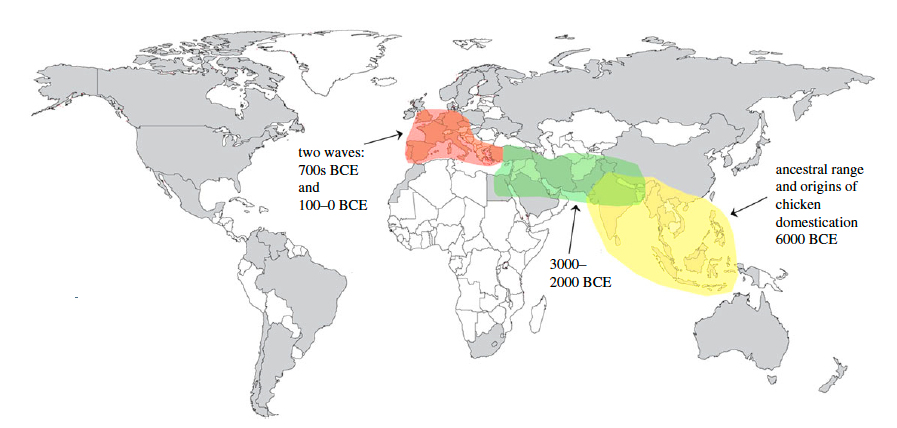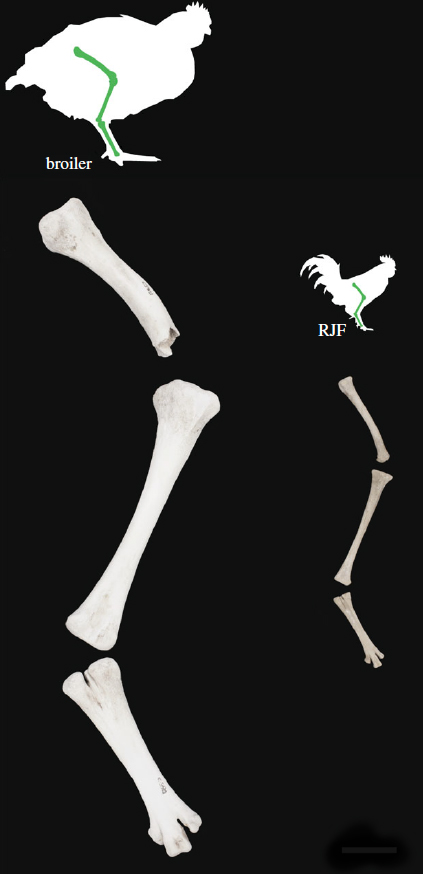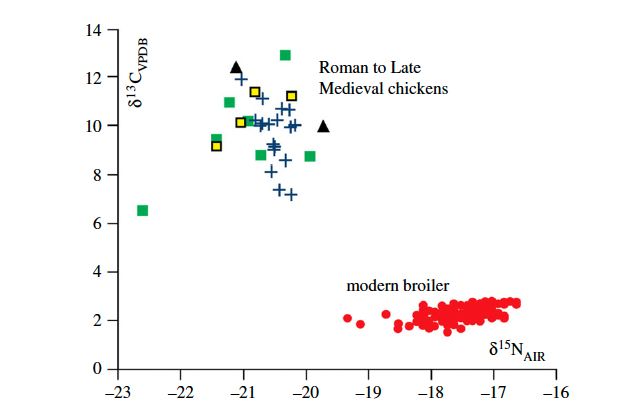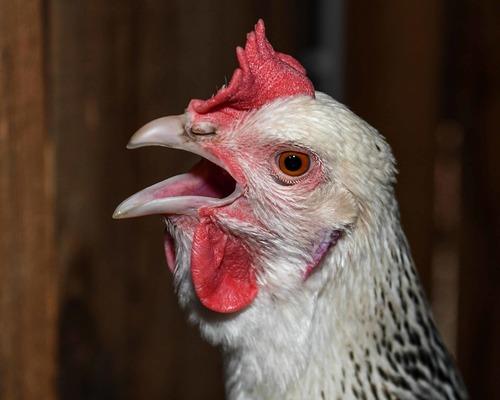Some 8,000 years ago, our ancestors struck a Faustian bargain with a creature wandering about in the neighborhood; we feed you, you feed us – it seems, at the time, to be a good collaboration. Our partner, the red jungle fowl, better known as the domesticated chicken, may not have gotten the better part of that deal. Researchers suggest that chickens may be the first accessible artifact of today’s Anthropocene era when Sapiens ruled the earth, and our co-evolution with the chicken provides insight into how we can and do alter the “natural order.”
 Chicken Zero, that first red jungle fowl began domesticity in Southeast Asia, their journey with humans is depicted to the left. First, along the Spice Route, the Phoenicians brought them to the Iberian peninsula and the Spanish schlepping them along during their explorations, leaving many of them in the New World. Like humans, chickens are now global, migrating along trade routes, just like our languages and cultures spread and intermingled.
Chicken Zero, that first red jungle fowl began domesticity in Southeast Asia, their journey with humans is depicted to the left. First, along the Spice Route, the Phoenicians brought them to the Iberian peninsula and the Spanish schlepping them along during their explorations, leaving many of them in the New World. Like humans, chickens are now global, migrating along trade routes, just like our languages and cultures spread and intermingled.
Today chickens are found in a wide range of climates; their climatic resilience sustained by increasingly complex control of our indoor weather and adequate housing. Some might point out that the chicken’s home is provided for them, they cannot build these structures; but then again, how many of us could build our homes ourselves? Chicken populations like ours, are increasingly dependent upon technologic innovation to be sustained.
 Chicken bones are everywhere on the planet and cast light on the effect of Sapiens in the natural world. Anthropologists have studied the width of chicken bones, used as a proxy for body size to discern the impact of Chicken Zero’s Faustian bargain (graphic to the left). Perhaps we were too busy pillaging and conquering, but until the mid 13thcentury, the domestic chicken was a close match to Chicken Zero. Then their size began to increase, presumably because of the advantages of domestication, food, and shelter, as well as a desire, on the part of farmers, to raise a better bird – more eggs, more meat, more bang for the buck. In those pre-Mendelian times, farmer’s genetic guidance, their competence without comprehension, resulted in continued growth peaking in the early 1900s.
Chicken bones are everywhere on the planet and cast light on the effect of Sapiens in the natural world. Anthropologists have studied the width of chicken bones, used as a proxy for body size to discern the impact of Chicken Zero’s Faustian bargain (graphic to the left). Perhaps we were too busy pillaging and conquering, but until the mid 13thcentury, the domestic chicken was a close match to Chicken Zero. Then their size began to increase, presumably because of the advantages of domestication, food, and shelter, as well as a desire, on the part of farmers, to raise a better bird – more eggs, more meat, more bang for the buck. In those pre-Mendelian times, farmer’s genetic guidance, their competence without comprehension, resulted in continued growth peaking in the early 1900s.
Mighty Morphing Time
 World War II’s Manhattan Project gave us more than nuclear weapons, and arguably is the beginning of scientific collaboration and the synergy, for bad or good, of the industrial-government complex. The end of the war left a great deal of industrial capacity no longer necessary for swords, and they were duly beaten into plowshares.
World War II’s Manhattan Project gave us more than nuclear weapons, and arguably is the beginning of scientific collaboration and the synergy, for bad or good, of the industrial-government complex. The end of the war left a great deal of industrial capacity no longer necessary for swords, and they were duly beaten into plowshares.
Foreshadowing Netflix’s quest for the best predictive algorithm or the XPrize, the A&P chain of grocery stores and the USDA sponsored a contest to grow the largest chicken, the Chicken of Tomorrow Program. Like the nuclear proliferation that followed the Manhattan Project, the Chicken of Tomorrow featured its version of an arms (drumstick?) race. The figure depicts the relative size difference in today's broiler and Chicken Zero.
- Chicken now grow three times faster to a five-fold increase in size, dwarfing Chicken Zero.
- At any one time, there are 22.7 billion chickens on earth. To give that number perspective, the runner-up in population are the 1.5 billion red-billed quelea. All considered chickens are three-fold more common than all wild bird species combined or for that matter the number of chicken’s overlords, humans.
- Consumption of chicken is rapidly overtaking the consumption of that other white meat, pork, driven primarily by increasing consumption in the developing countries. 65 billion chickens were consumed in 2016.
Now all this growth comes at some cost. Chicken breeding puts the concept of cradle to grave care in a whole new perspective reflecting the vertical integration of industries. From birth to death, chickens pass from one expert of efficiency to another – from breeder facilities that provide eggs, to hatcheries where eggs are incubated, to “finishing units” were chickens live their caged or free-range lives, and then on to slaughterhouses.
 The lifespan of an egg-laying chicken, one year; that of a broiler, 5 to 7 weeks, both in sharp contrast to Chicken Zero’s 3 to 11-year lifespan. We may well have bred chickens less likely to survive on their own. Evidence from some breeder studies found that increasing the broiler’s lifespan by as little as two weeks results in more deaths before slaughter than the standard 5 to 7-week time-frame. The broiler chicken may be an evolutionary dead end unless we keep up our end of that Faustian bargain, we feed you, you feed us. The graph shows the significantly decreased diversity of the chicken over time based upon their collagen formation.
The lifespan of an egg-laying chicken, one year; that of a broiler, 5 to 7 weeks, both in sharp contrast to Chicken Zero’s 3 to 11-year lifespan. We may well have bred chickens less likely to survive on their own. Evidence from some breeder studies found that increasing the broiler’s lifespan by as little as two weeks results in more deaths before slaughter than the standard 5 to 7-week time-frame. The broiler chicken may be an evolutionary dead end unless we keep up our end of that Faustian bargain, we feed you, you feed us. The graph shows the significantly decreased diversity of the chicken over time based upon their collagen formation.
Chickens are natural omnivores but are now raised primarily on grains, mostly cereals — a diet designed to accelerate growth, trading food security and a homogenized nutritional intake for the vagaries and varieties of food in the wild. Chicken is our most efficient meat protein source; growing chicken feed requires the least amount of land. But the nitrogenous wastes from that effort are more than twice the waste associated with staple crops used to directly feed humans, like rice, wheat, and potatoes.
The quest for scale and efficacy has reimagined the chicken’s body as well as life. The pursuit of meat in a short period of time has resulted in breeds with rapidly growing muscle.
- In turn, resulting in a change in the center of gravity downwards
- Reduced pelvic and limb muscle mass (think thighs and drumsticks)
- Creating a low-slung, wide body chicken with decreasing steadiness and locomotion
- And an increase in bone-related diseases, osteopathies.
What might we learn from our long-standing relationship with chickens? There are simple lessons that both of us do better when adequately fed and housed. And more nuanced messages, that too much of a good thing, like chicken feed, can alter our body and both alleviate and promote disease. We have raised the broiler chicken to an unprecedented size, and while it is easy enough to see the changes we have brought to the chicken, should we not consider how the chicken and our quest for scale and efficiency may have changed us?
Source: "The broiler chicken as a signal of a human reconfigured biosphere." Royal Society Open Science. DOI: 10.1098/rsos.180325 (The authors are careful to note that no chickens were harmed for these studies and those bone measurements were made from chickens used in nutritional trials that were opportunistically available for research.)




